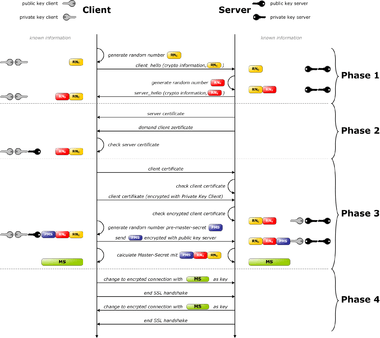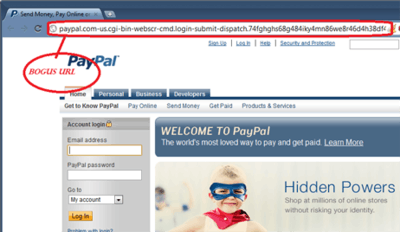Spoofed URL
A Spoofed URL describes one website that poses as another website. It sometimes applies a mechanism that exploits bugs in web browser technology, allowing a malicious computer attack. Such attacks are most effective against computers that lack recent security patches. Others are designed for the purpose of a parody.
During such an attack, a computer user innocently visits a web site and sees a familiar URL in the address bar such as http://www.wikipedia.org but is, in reality, sending information to an entirely different location that would typically be monitored by an information thief. When sensitive information is requested by a fraudulent website, it is called phishing.
The user is typically enticed to the false website from an email or a hyperlink from another website.
In another variation, a website may look like the original, but is in fact a parody of it. These are mostly harmless, and are more noticeably different from the original, as they usually do not exploit bugs in web browser technology.
This can also take place in a hosts file. It can redirect a site(s) to another IP, which could be a spoofed website.
Cyber Security
Spoofing is the act of deception or hoaxing.[1] URLs are the address of a resource (as a document or Web site) on the Internet that consists of a communications protocol followed by the name or address of a computer on the network and that often includes additional locating information (as directory and file names).[2] Simply, a spoofed URL is a web address that illuminates an immense amount of deception through its ability to appear as an original site, despite it not being one. In order to prevent falling victim to the prevalent scams stemmed from the spoofed URLs, major software companies have come forward and advised techniques to detect and prevent spoofed URLs.

Detection
In order to prevent criminals from accessing personal information, such as credit card information, bank account/routing numbers, and one’s telephone number, home address, etc. it is important to learn and understand how these spoof websites can be detected. It is very important to first verify the name of the site on a digital certification through the use of SSL/TLS. Always try to identify the actual URL for the web page you are on. Make sure you are able to see the fully URL for any hyperlink, so that you can examine the address. Some characters that are commonly found in the URL of a spoofed web page are: %00, %01, @. Sometimes spoofed web sites can differ by a single letter or number in the URL. In addition, set your Internet security level to high to ensure that your computer is protected from possible attacks from spoofed sites. In general, only input personal information on a Web site if the name has been verified on the digital certificate. Also, if you have any concern about the confidentiality of a web site leave the page immediately.[3]
Prevention
Spoofed URL, a universal defining identity for phishing scams, pose a serious threat to end-users and commercial institutions. Email continues to be the favorite vehicle to perpetrate such scams mainly due to its widespread use combined with the ability to easily spoof them.[4] Several approaches, both generic and specialized, have been proposed to address this problem. However, phishing techniques, growing in ingenuity as well as sophistication, render these solutions weak. In order to prevent users from future victimization stemmed from a spoofed URL, Internet vigilantes have published numerous tips to help users identify a spoof.

The most common are: using authentication based on key exchange between the machines on your network, using an access control list to deny private IP addresses on your downstream interface, implementing filters of both inbound and outbound traffic, configuring routers and switches if they support such configuration, to reject packets originating from outside the local network that claim to originate from within, and enable encryption sessions in the router so that trusted hosts that are outside your network can securely communicate with your local hosts.[5] Ultimately, protection comes from the individual user. Keeping up with new spoofing techniques or scams will readily allow one to identify a scam and most importantly keep information secure and personal.

Susceptible Targets
PayPal, an e-commerce business allows money transactions to be made through the Internet and is a common target for Spoofed URLs. This forgery of a legitimate PayPal website allows hackers to gain personal and financial information and thus, steal money through fraud. Along with spoof or fake emails that appear with generic greetings, misspellings, and a false sense of urgency, spoofed URLs are an easy way for hackers to violate one’s PayPal privacy. To combat these deceptive URLs, make sure to only enter your PayPal password on PayPal pages that begin with https://www.paypal.com/, and although, a spoof URL might contain the word PayPal, this does not mean it should be trusted. For example, www.paypalsecure.com, includes the name, but is a spoof URL designed to deceive. Remember to always log in to PayPal through a new window browser and never log in through email. In the case that you do receive a suspected Spoof website, email and forward the entire email to [email protected] to help prevent the URL from tricking other PayPal users.[6]
Common Crimes
A major crime associated with Spoofed URL’s is identity theft. The thief will make a Spoofed URL website that is similar to the website the user is trying to go to, and when taken to the webpage, it will look nearly identical. Then, if the user is shopping and enters all of their information to pay for the items, they inadvertently give the thief their credit card and identity information. The websites will post products at “too good to be true” prices, and lure those who are new to the internet and looking for a good deal. Crimes like these happen quite often, and most frequently occur during the heaviest trafficked online shopping period of the year, between the holidays of Thanksgiving and Christmas.[7] Another crime associated with Spoofed URL’s is setting up a fake anti-malware software. An example of this would be Ransomware, a fake anti-malware software that locks up important files for the computer to run, and forces the user to pay a ransom to get the files back. If the user refuses to pay, after a certain period of time, the Ransomware will delete the files off of the computer, essentially causing the computer to crash. These programs usually come up in ads on the side of popular websites, such as dating websites and even social media like Twitter and Facebook. Also, these can come up as attachments in emails tied to phishing. Phishing scams are also another major way that users can get tricked into scams (see below).
Phishing
Phishing is a scam by which an e-mail user is duped into revealing personal or confidential information which the scammer can use illicitly.[8] Phishing is the action of fraudsters sending an email to an individual, hoping to seek private information used for identity theft, by falsely asserting to be a reputable legal business. Phishing is performing through emails containing a Spoofed URL, which links them to a Web site. Since it usually appears in the form on an email, it is crucial to not rely just on the address in the “from” field in order to prevent phishing. Computer users should also look out for spelling mistakes within the websites URLs, as this is another common sign to look out for in a phishing email.[9] The Web site whose URLs are in the e-mails request individuals to enter personal information so businesses can update it in their system. This information often includes passwords, credit card numbers, social security, and bank account numbers. In turn the email recipients are giving these fake businesses their information the real businesses already have.
See also
- Computer insecurity
- Hosts File
- IDN homograph attack
- Internet fraud prevention
- Social engineering (computer security)
- Spoofing attack
References
- ↑ "Spoof". Merriam-Webster. Retrieved 2014-03-07.
- ↑ "URL". Merriam-Webster. Retrieved 2014-03-07.
- ↑ "Steps that you can take to help identify and to help protect yourself from deceptive (spoofed) Web sites and malicious hyperlinks". Microsoft. Retrieved 2014-03-18.
- ↑ Chandrasekaran, Madhusudhanan. Phoney: Mimicking User Response to Detect Phishing Attacks. pp. 1–15.
- ↑ Hassel, Jonathan. "Prevent IP Spoofing". Retrieved 2014-03-09.
- ↑ "10 ways to recognize fake (spoof) e-mails". PayPal. Retrieved 2014-03-19.
- ↑ "New E-Scams and Warnings". Federal Bureau of Investigation. Retrieved 2014-03-18.
- ↑ "Phishing". Meriam-Webster. Retrieved 2014-03-19.
- ↑ "Phishing, Spoofing, Vishing". DSP BlackRock Mutual Fund. Retrieved 2014-03-17.
External links
- Secunia security describes Microsoft Internet Explorer URL spoofing vulnerability 2003
- Microsoft Knowledge Base Article 833786 - Steps that you can take to help identify and to help protect yourself from deceptive (spoofed) Web sites and malicious hyperlinks.